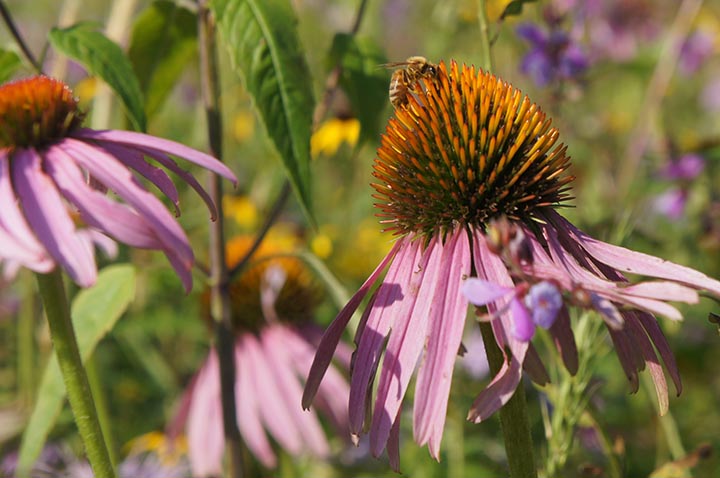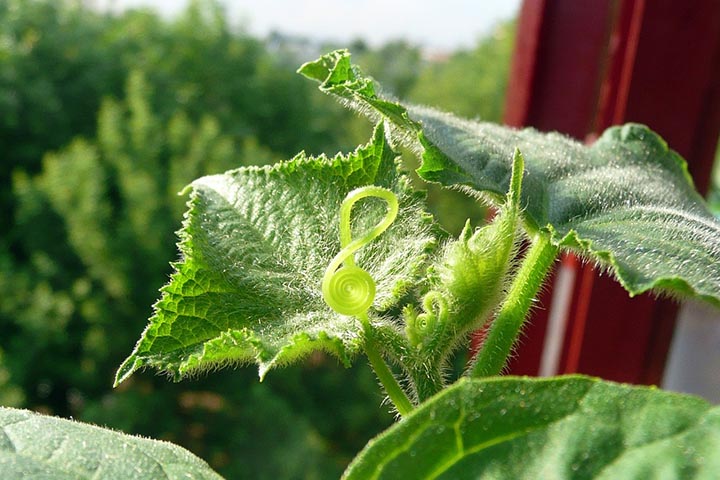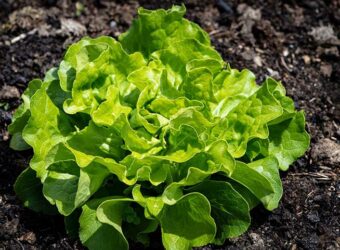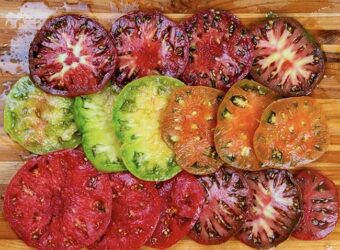Whether you want to try your hand at making pickles or are looking for a refreshing snack to help you beat summer’s heat, cucumbers are the answer. And it’s hard to beat a homegrown cucumber.
One way to grow healthy cucumber plants at home is by practicing companion planting. This involves designing your garden in a way that allows plants to benefit each other.
I’ve found that companion planting can help keep plants healthy and limit garden work. In this article, I’ll share what I know about selecting the best companion plants for your cucumbers.
What Are Companion Plants?
Companion plants provide benefits to their surrounding plants. They may repel pests, help keep weeds in check, attract beneficial insects, or improve the soil texture.
When it comes to selecting companion plants for cucumbers, remember that not all plants have the same companion plants. That means what might be a great companion plant for a tomato may not provide many benefits to a cucumber plant.
Still not sure about what plants go well with cucumbers? Then stay with me as I cover some of the best companion plants for cucumbers.
Best Cucumber Companion Plants
As I mentioned above, a plant may be considered a companion plant if it provides one or more benefits. I’ve broken down the companion plants by the benefits they provide so you can arrange your garden to keep your cucumber plants happy.
Best Cucumber Companion Plants to Increase Predatory Insects
You know that delightfully crisp and juicy crunch that makes a cucumber a cucumber? Well, you’re not the only one who wants to enjoy it.
Many different pests feed on cucumber fruits, and even more bugs feed on the plant’s leaves.
Some of the most common cucumber pests include cucumber beetles, aphids, thrips, slugs, and whiteflies.
Not only can these bugs eat away your cucumber plant, but they can also spread disease from plant to plant. For example, cucumber beetles can transmit bacterial wilt, a disease that can quickly transform healthy cucumber plants into sad, drooping excuses of plants.
Spraying insecticides is one way to rid your garden of these pesky critters. However, this isn’t the only way! You can also turn to nature’s natural predators.
Most cucumber pests are a beloved food source of at least one insect. For example, aphids are prey of ladybugs, green lacewing larvae, and parasitic wasp larvae.
However, not all life stages of these predatory insects feed on pests. Many of the adults feed on nectar and pollen rather than insects.
That means planting flowering plants in your garden can help attract (and keep) these good bugs.
1. Sweet Alyssum
With many tiny flowers that insects of all kinds love, sweet alyssum is a must-have if you want to attract good bugs to your garden. Hoverflies, parasitic wasps, green lacewings, and other good bugs visit these flowers to feed on the nectar and pollen.
Since sweet alyssum plants remain under a foot tall, you’ll need to be thoughtful when planting them with your cucumbers. If you’re not careful, the sprawling cucumber plants can easily take over the delicate flowers.
If you allow your cucumber plant to trail across the ground, be aware that the vines can grow up to ten feet away from the base of the plant. That means you should plant sweet alyssum plants at least this far away from where you plant your cucumbers.
However, if you’re growing your cucumbers on a trellis, you can plant the sweet alyssum about three feet away from the larger plants.
Another option is to plant sweet alyssum in pots and place these pots around your garden.
2. Yarrow
If you’re looking to plant a perennial flower that will attract beneficial insects to your garden for years to come, yarrow is a great choice. It produces loads of tiny flowers that are arranged in tight clusters.
I’ve found that as long as you cut or deadhead mature blooms, yarrow plants will continue producing flowers all summer long. And that means lots of good bugs in your garden!
Since yarrow is a perennial, you’ll want to put some thought into where you plant it. I find that it’s often best to plant it on the edges of your garden so you don’t have to worry about it interfering with other plants. Try mixing it with other perennial flowers like coneflower and mountain mint to create a haven for beneficial insects.
As long as yarrow plants are mature, they can handle cucumbers climbing over them a bit. You should still plant cucumbers at least three feet away from the tall yarrow plants.
3. Dill
These two plants are a match in the kitchen and a match in the garden! When you leave dill plants in the ground long enough, they will eventually produce many umbels of tiny yellow flowers. And these little blooms are a favorite of tiny insects like parasitic wasps and hoverflies.
Since dill plants reach three to five feet tall when they produce flowers, you can plant them quite closely to cucumber plants. However, you’ll want to plant your dill before planting the fast-growing cucumbers.
I find that tucking dill seedlings in the ground first, then planting cucumbers about two weeks later is a good option. Leave about three feet of space between the plants to allow enough room for them to grow.
You can also plant dill further away from your cucumber plants. Even if it’s twenty feet away, its flowers will still attract good bugs to your garden.
And remember that the dill foliage alone won’t attract many predatory insects—you’ll need to wait until the plants go to flower to receive the benefits.
Best Cucumber Companion Plants for Weed Control
Honestly, I find the best way to control weeds around cucumbers is with mulch. That’s because cucumbers quickly produce vines that cover a wide area, taking over any vegetation that’s in their path.
I like to use landscape fabric, but you can also utilize straw, woodchips, or other mulching materials.
That said, you can attempt to use some companion plants for weed control. However, if you do this, you’ll need to consider the cucumber plants’ fast-growing nature.
With this in mind, I like to utilize one of two options when it comes to companion planting to control weeds.
First, you can use a cover crop and terminate it to produce a grown-in-place mulch. When the cover crop is dead, you can plant your cucumbers into the dead material.
Another option is to plant quick-growing crops next to your cucumber plants. These crops will help suppress some weeds and be ready to harvest before the cucumber vines overtake them.
4. Rye
Rye is a great cover crop with many advantages.
It’s known for its allelopathic properties, aka its ability to suppress weeds by releasing chemicals into the soil. It also helps hold soil and nutrients in place when you are not growing a cash crop.
And since rye produces so much biomass, it makes a great companion plant for cucumbers! However, rather than growing rye and cucumbers simultaneously, you’ll want to plant your rye before you intend to put your cukes into the ground.
Since winter rye can withstand cold temperatures, I like to plant rye seeds in the fall and let the plants stay in the ground throughout the winter. During this time, they’ll hold the soil in place and help prevent erosion.
When warmer weather arrives, the rye will resume growing. This is when you need to start paying attention to the crop.
That’s because terminating rye can be a bit tricky. If you try to kill the crop too early, it may bounce right back. And if you wait too long, the crop can set seed and leave you with a garden full of unwanted rye plants. Therefore, you should terminate your plants when they are all producing pollen.
I like terminating rye plants by crimping and flattening them to the ground. This creates a nice thick mulch where I can then plant cucumbers and other long-day crops.
On a small scale, rolling/crimping can be done with a t-post and some string. Tie one end of the string to either end of the t-post to create a handle. Place the t-post flat on the ground, then hold the center of the string to help you lift and move the post.
Place the t-post on the rye and then step down on it to crimp the stalks of the plants. Move the post about a foot forward and repeat this process until all the rye is flattened and crimped.
Wait for about two weeks until the rye stalks have dried out and turned brown. At this point, it’s time to plant your cucumbers in your home-grown mulch!
5. Buckwheat
Buckwheat is a cover crop that works great before or alongside cucumbers. However, if you want to utilize its ability to suppress weeds, you should plant it before you plant your cucumbers.
One of the great things about buckwheat is that it thrives in hot weather. So if you have an empty space in your summer garden and aren’t ready to plant crops like cucumbers, you can plant some buckwheat to help improve the soil and keep weeds in check.
Buckwheat grows rapidly in the summer and begins to flower about a month and a half after planting. When all of the plants are flowering, it’s time to terminate the crop by mowing or crimping.
Once you’ve terminated the buckwheat, you can plant cucumbers or other crops into the soil.
While buckwheat can help compete with weeds, it also provides other benefits to your garden. Its tiny white flowers attract all kinds of beneficial insects, from parasitic wasps to bees to hoverflies.
6. Radishes
Radishes are a great choice if you’re looking for a crop to plant beside your cucumbers. These quick-growing crops are ready to harvest in as little as 21 days, which means they’ll be out of the garden before sprawling cucumber vines overtake them.
By planting radishes and cucumbers at the same time, you can harvest two crops in an area where you would normally harvest only one. And the radishes can help suppress some weeds before cucumber plants mature.
I like to plant a row of small radishes about a foot or two away from where I plant my cucumber seeds. The radishes will be ready to harvest just as the cucumber plants are beginning to encroach on them.
Make sure to plant small, quick-to-mature radishes rather than larger radishes.
Best Cucumber Companion Plants to Attract Pollinators
Healthy cucumber plants produce an abundance of both male and female flowers. And each female flower has the potential to turn into a cucumber!
However, the majority of cucumber varieties need their flowers to be pollinated in order to produce fruit. The only exception to this rule is if a cucumber variety is parthenocarpic, which means it does not need to be fertilized to produce fruit.
Attracting pollinators like bees and flies to your garden can help increase the likelihood that your cucumber flowers will be pollinated. I’ve found that pollinators of all kinds love the following plants, which means they’re a good addition to your garden.
7. Coneflower

Coneflowers are one of my top choices when it comes to selecting plants that will attract pollinators to the garden. These perennial plants produce blooms for years on end and can survive drought, poor soil, and other less-than-ideal conditions.
The plants produce flowers that traditionally have light purple flowers, but new varieties can have petals that are yellow, orange, or other colors. No matter the petals’ color, pollinators love these flowers. I’ve watched bees and butterflies carefully explore each coneflower, collecting pollen as they go from one flower to another.
Not only do coneflower blooms provide food for pollinators, but their plants can provide habitat for pollinators throughout the rest of the year. When the flowers fade in the fall, solitary bees and other insects can use the hollow stem as a place to create their home.
Since coneflowers are perennials, you’ll want to put some thought into where you plant them. The plants can reach up to four feet tall and a few feet wide, so you should plant them somewhere where they won’t encroach on other plants.
One of my favorite ways to plant coneflowers is to tuck them into a hedgerow or pollinator garden with other perennial flowering plants. Even if these flowers are ten or twenty feet away from your cucumber plants, they can still attract pollinators to the fruiting plants.
8. Borage
Borage produces loads upon loads of small star-shaped flowers that range in color from blue to pink. And when I say loads, I mean loads! It seems that mature plants have at least twenty new flowers each day.
And all these tiny flowers attract pollinators such as bumblebees, hoverflies, and sweat bees. Many of the pollinators that flock to borage flowers also help pollinate cucumbers.
It’s important to know that a single borage plant can get quite tall and quite wide, so you should provide it with plenty of space to grow. I like to ensure that there are at least three feet of space around all sides of the plant.
If you’re planting borage next to your cucumber plants, remember that cucumbers trail and borage plants grow tall. To make sure each has ample space to grow, allow five feet between the plants.
Another thing to note about borage is that it readily self-seeds. That means that even if you plant one borage plant, you’ll likely end up with more than one plant before long, and even in years to come.
9. Anise Hyssop
If you’re looking for a plant that attracts pollinators and has culinary uses, consider anise hyssop. This perennial plant produces spikes of light purple flowers that attract pollinators including bees, wasps, flies, and butterflies.
The plant will continue to produce flowers from the summer through the early fall, especially if you deadhead the old flowers. Although anise hyssop is a perennial, plants typically only live for a few years.
These plants grow up to four feet tall and two feet wide. Therefore, you’ll want to consider the plant’s ability to shade other plants and its spread when planting it in your garden.
I personally like to keep it on the edge of my garden or in a perennial pocket garden to make managing it easy. Mixing it with other flowering perennials like yarrow, coneflower, black-eyed Susan, and mountain mint will help attract both pollinators and predatory insects to your garden.
Another benefit of anise hyssop is its great flavor! Both the leaves and flowers have a slightly sweet and fragrant anise flavor that lends itself well to teas, simple syrups, and more.
10. Mountain Mint
While you may think of gum and toothpaste when you think of mint, there are many other mints besides peppermint and spearmint. Mountain mint is a type of mint that’s known for its ability to attract pollinators more so than for its fragrance and aroma.
The plant produces lots of small white flowers that bees, butterflies, parasitic wasps, and other beneficial insects flock to. Many of these insects also benefit cucumbers either by pollinating the flowers or eating the pests.
Mountain mint is a perennial that mixes well with other flowering perennial plants. Although it spreads a bit via rhizomes, it doesn’t spread as aggressively as other types of mint. I’ve planted it in the ground and been able to contain it within a relatively small area.
As I’ve mentioned with other flowering plants, I like to plant mountain mint near the edges of my garden or in a special perennial pollinator garden. This allows for easy maintenance and gives crops like cucumbers plenty of space to grow.
Frequently Asked Questions
What Plants Should I Avoid Planting with Cucumbers?
Since cucumber plants are trailing crops, you should avoid planting them too close to most tender crops. This includes lettuce, arugula, beets, and more.
Unless you’re growing a quick-growing crop alongside cucumbers or training the cucumbers on a trellis, you should allow at least four feet between cucumber plants and other crops.
What Month Should I Plant Cucumbers?
Cucumbers are a warm-weather crop that take around two months to mature. You should wait until the danger of frost has passed in the spring before planting cucumbers, and ensure you have at least three frost-free months when planting them in the summer.
In most areas, you can plant cucumbers in May, June, July, and August.
Can I Plant Cucumbers Next to Tomatoes?
You can plant cucumbers and tomatoes next to each other as long as both types of plants have enough space. Allow at least five feet of space between untrellised cucumbers and tomato plants.
Grow Healthy Cucumbers with the Help of Companion Plants
Whether you’re looking to attract beneficial insects or keep weeds at bay, you can find plants that will help you grow healthy cucumbers. Remember to account for the cucumber plant’s spreading nature when you’re laying out your garden, and trellis the plants if you need more space.






